Exploring Challenges of IoT in Farming & Report Format Expectations
VerifiedAdded on 2023/06/07
|5
|1148
|384
Report
AI Summary
This report explores the challenges associated with implementing the Internet of Things (IoT) in farming, focusing on issues such as soil testing difficulties, adverse climatic impacts, and the potential for soil degradation due to advanced technologies. It also addresses concerns about job displacement for farmers. The report outlines the expected format, including sections on the abstract, introduction, literature review, the integration of IoT and cloud computing, soil monitoring, soil testing, and the role of IoT and mobile cloud in farming. It highlights the benefits of IoT in predicting diseases, pre-monitoring soil conditions, and facilitating data management through cloud computing, ultimately aiming to improve farming practices while acknowledging the potential drawbacks. Desklib offers a variety of solved assignments and past papers for students.
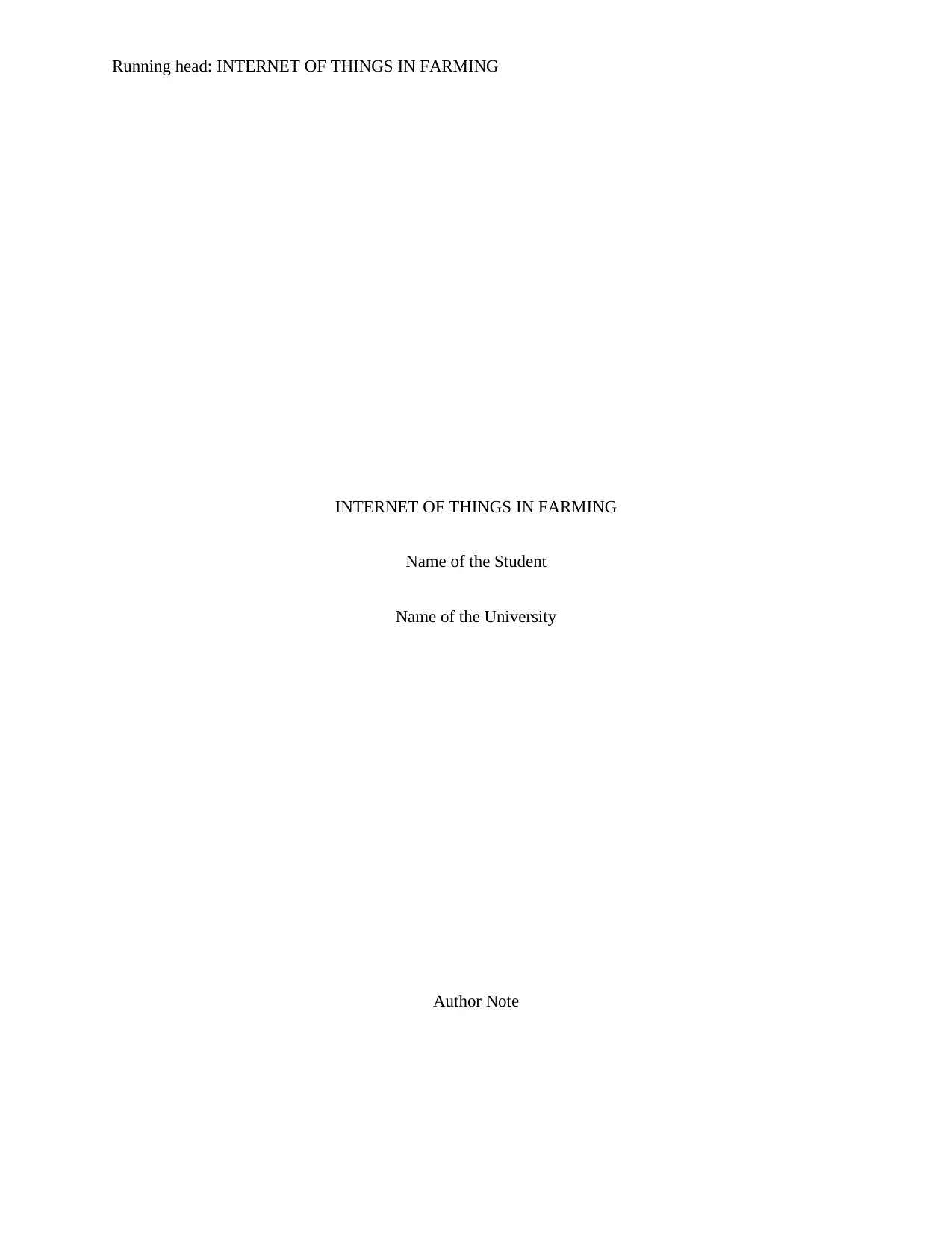
Running head: INTERNET OF THINGS IN FARMING
INTERNET OF THINGS IN FARMING
Name of the Student
Name of the University
Author Note
INTERNET OF THINGS IN FARMING
Name of the Student
Name of the University
Author Note
Paraphrase This Document
Need a fresh take? Get an instant paraphrase of this document with our AI Paraphraser
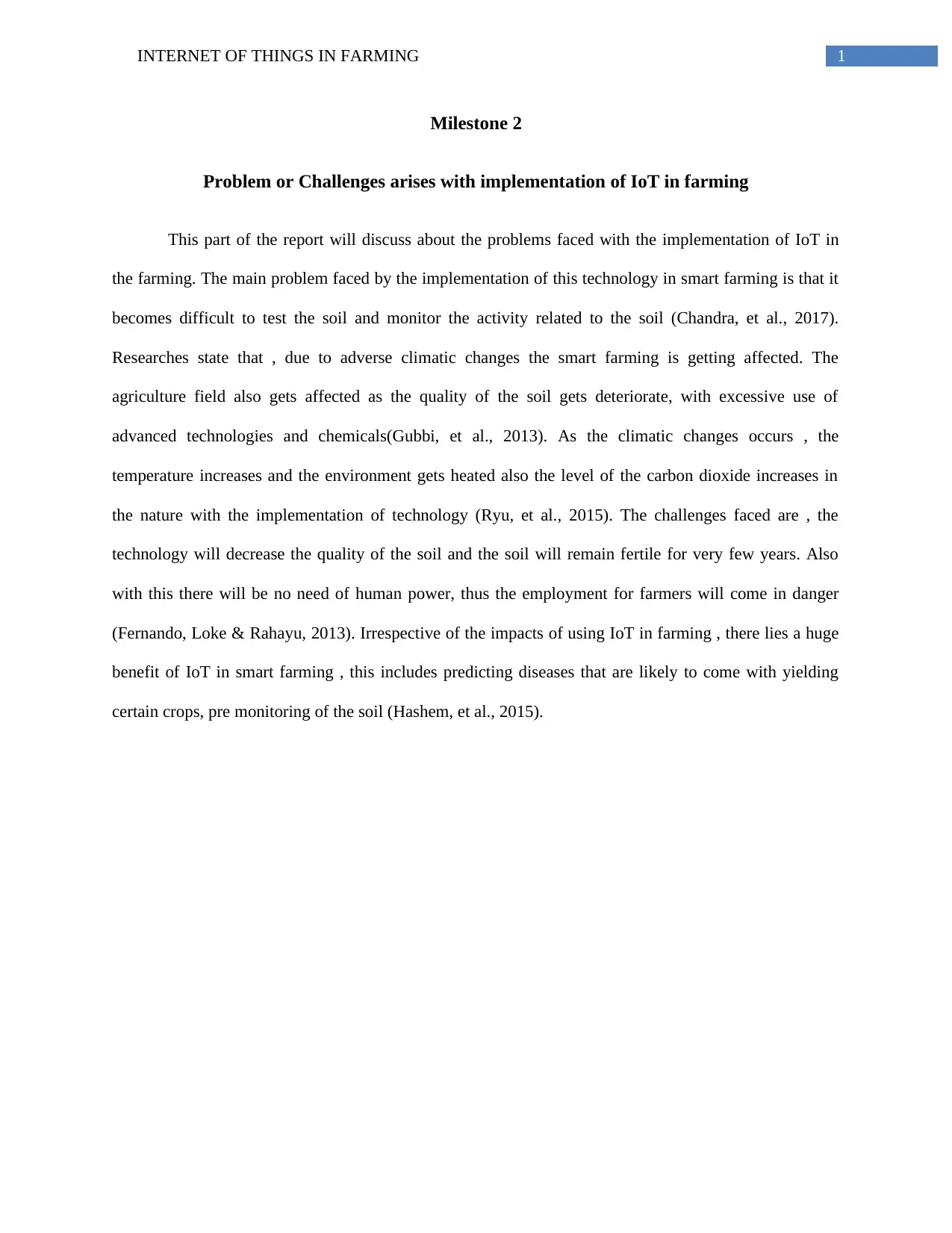
1INTERNET OF THINGS IN FARMING
Milestone 2
Problem or Challenges arises with implementation of IoT in farming
This part of the report will discuss about the problems faced with the implementation of IoT in
the farming. The main problem faced by the implementation of this technology in smart farming is that it
becomes difficult to test the soil and monitor the activity related to the soil (Chandra, et al., 2017).
Researches state that , due to adverse climatic changes the smart farming is getting affected. The
agriculture field also gets affected as the quality of the soil gets deteriorate, with excessive use of
advanced technologies and chemicals(Gubbi, et al., 2013). As the climatic changes occurs , the
temperature increases and the environment gets heated also the level of the carbon dioxide increases in
the nature with the implementation of technology (Ryu, et al., 2015). The challenges faced are , the
technology will decrease the quality of the soil and the soil will remain fertile for very few years. Also
with this there will be no need of human power, thus the employment for farmers will come in danger
(Fernando, Loke & Rahayu, 2013). Irrespective of the impacts of using IoT in farming , there lies a huge
benefit of IoT in smart farming , this includes predicting diseases that are likely to come with yielding
certain crops, pre monitoring of the soil (Hashem, et al., 2015).
Milestone 2
Problem or Challenges arises with implementation of IoT in farming
This part of the report will discuss about the problems faced with the implementation of IoT in
the farming. The main problem faced by the implementation of this technology in smart farming is that it
becomes difficult to test the soil and monitor the activity related to the soil (Chandra, et al., 2017).
Researches state that , due to adverse climatic changes the smart farming is getting affected. The
agriculture field also gets affected as the quality of the soil gets deteriorate, with excessive use of
advanced technologies and chemicals(Gubbi, et al., 2013). As the climatic changes occurs , the
temperature increases and the environment gets heated also the level of the carbon dioxide increases in
the nature with the implementation of technology (Ryu, et al., 2015). The challenges faced are , the
technology will decrease the quality of the soil and the soil will remain fertile for very few years. Also
with this there will be no need of human power, thus the employment for farmers will come in danger
(Fernando, Loke & Rahayu, 2013). Irrespective of the impacts of using IoT in farming , there lies a huge
benefit of IoT in smart farming , this includes predicting diseases that are likely to come with yielding
certain crops, pre monitoring of the soil (Hashem, et al., 2015).
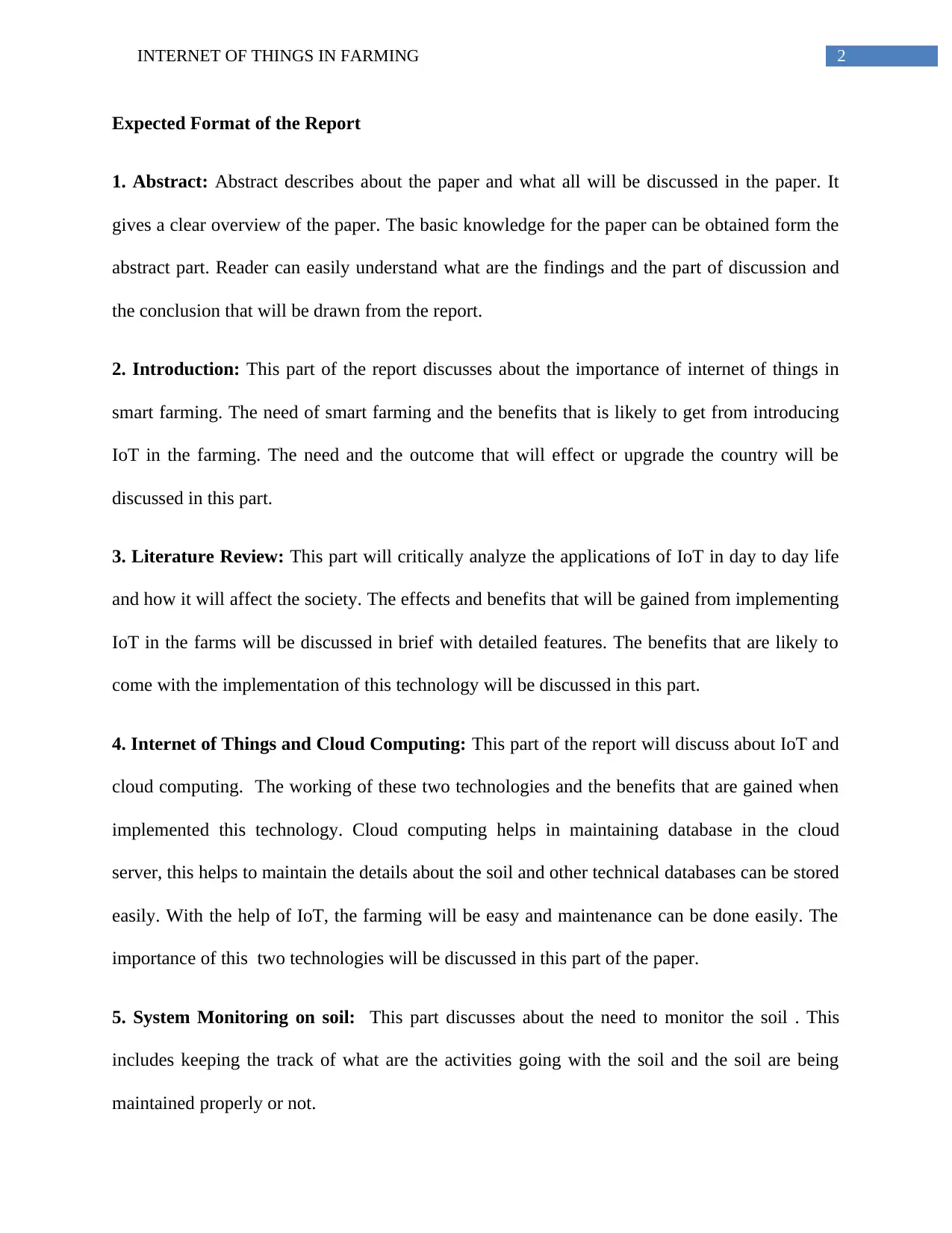
2INTERNET OF THINGS IN FARMING
Expected Format of the Report
1. Abstract: Abstract describes about the paper and what all will be discussed in the paper. It
gives a clear overview of the paper. The basic knowledge for the paper can be obtained form the
abstract part. Reader can easily understand what are the findings and the part of discussion and
the conclusion that will be drawn from the report.
2. Introduction: This part of the report discusses about the importance of internet of things in
smart farming. The need of smart farming and the benefits that is likely to get from introducing
IoT in the farming. The need and the outcome that will effect or upgrade the country will be
discussed in this part.
3. Literature Review: This part will critically analyze the applications of IoT in day to day life
and how it will affect the society. The effects and benefits that will be gained from implementing
IoT in the farms will be discussed in brief with detailed features. The benefits that are likely to
come with the implementation of this technology will be discussed in this part.
4. Internet of Things and Cloud Computing: This part of the report will discuss about IoT and
cloud computing. The working of these two technologies and the benefits that are gained when
implemented this technology. Cloud computing helps in maintaining database in the cloud
server, this helps to maintain the details about the soil and other technical databases can be stored
easily. With the help of IoT, the farming will be easy and maintenance can be done easily. The
importance of this two technologies will be discussed in this part of the paper.
5. System Monitoring on soil: This part discusses about the need to monitor the soil . This
includes keeping the track of what are the activities going with the soil and the soil are being
maintained properly or not.
Expected Format of the Report
1. Abstract: Abstract describes about the paper and what all will be discussed in the paper. It
gives a clear overview of the paper. The basic knowledge for the paper can be obtained form the
abstract part. Reader can easily understand what are the findings and the part of discussion and
the conclusion that will be drawn from the report.
2. Introduction: This part of the report discusses about the importance of internet of things in
smart farming. The need of smart farming and the benefits that is likely to get from introducing
IoT in the farming. The need and the outcome that will effect or upgrade the country will be
discussed in this part.
3. Literature Review: This part will critically analyze the applications of IoT in day to day life
and how it will affect the society. The effects and benefits that will be gained from implementing
IoT in the farms will be discussed in brief with detailed features. The benefits that are likely to
come with the implementation of this technology will be discussed in this part.
4. Internet of Things and Cloud Computing: This part of the report will discuss about IoT and
cloud computing. The working of these two technologies and the benefits that are gained when
implemented this technology. Cloud computing helps in maintaining database in the cloud
server, this helps to maintain the details about the soil and other technical databases can be stored
easily. With the help of IoT, the farming will be easy and maintenance can be done easily. The
importance of this two technologies will be discussed in this part of the paper.
5. System Monitoring on soil: This part discusses about the need to monitor the soil . This
includes keeping the track of what are the activities going with the soil and the soil are being
maintained properly or not.
⊘ This is a preview!⊘
Do you want full access?
Subscribe today to unlock all pages.

Trusted by 1+ million students worldwide
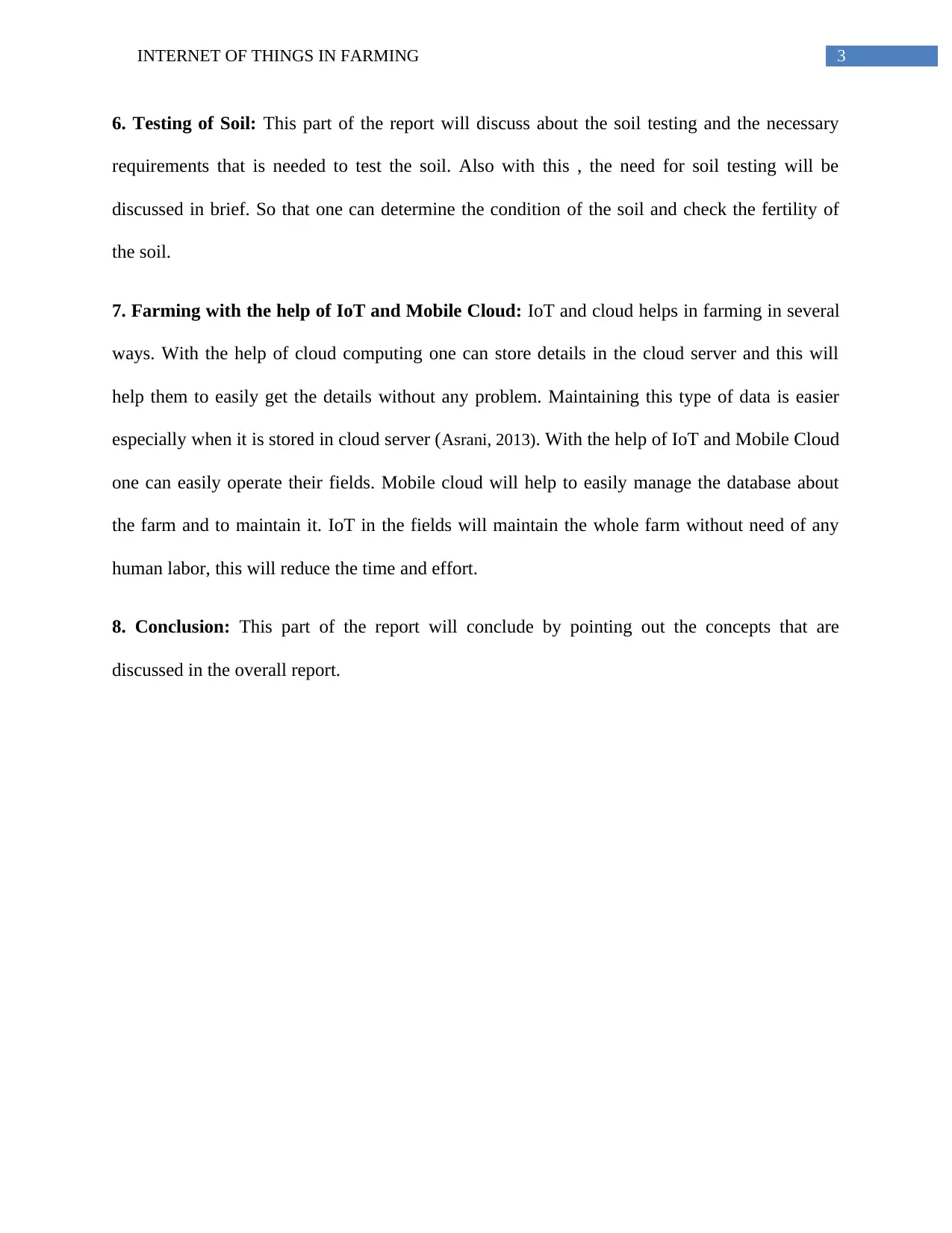
3INTERNET OF THINGS IN FARMING
6. Testing of Soil: This part of the report will discuss about the soil testing and the necessary
requirements that is needed to test the soil. Also with this , the need for soil testing will be
discussed in brief. So that one can determine the condition of the soil and check the fertility of
the soil.
7. Farming with the help of IoT and Mobile Cloud: IoT and cloud helps in farming in several
ways. With the help of cloud computing one can store details in the cloud server and this will
help them to easily get the details without any problem. Maintaining this type of data is easier
especially when it is stored in cloud server (Asrani, 2013). With the help of IoT and Mobile Cloud
one can easily operate their fields. Mobile cloud will help to easily manage the database about
the farm and to maintain it. IoT in the fields will maintain the whole farm without need of any
human labor, this will reduce the time and effort.
8. Conclusion: This part of the report will conclude by pointing out the concepts that are
discussed in the overall report.
6. Testing of Soil: This part of the report will discuss about the soil testing and the necessary
requirements that is needed to test the soil. Also with this , the need for soil testing will be
discussed in brief. So that one can determine the condition of the soil and check the fertility of
the soil.
7. Farming with the help of IoT and Mobile Cloud: IoT and cloud helps in farming in several
ways. With the help of cloud computing one can store details in the cloud server and this will
help them to easily get the details without any problem. Maintaining this type of data is easier
especially when it is stored in cloud server (Asrani, 2013). With the help of IoT and Mobile Cloud
one can easily operate their fields. Mobile cloud will help to easily manage the database about
the farm and to maintain it. IoT in the fields will maintain the whole farm without need of any
human labor, this will reduce the time and effort.
8. Conclusion: This part of the report will conclude by pointing out the concepts that are
discussed in the overall report.
Paraphrase This Document
Need a fresh take? Get an instant paraphrase of this document with our AI Paraphraser
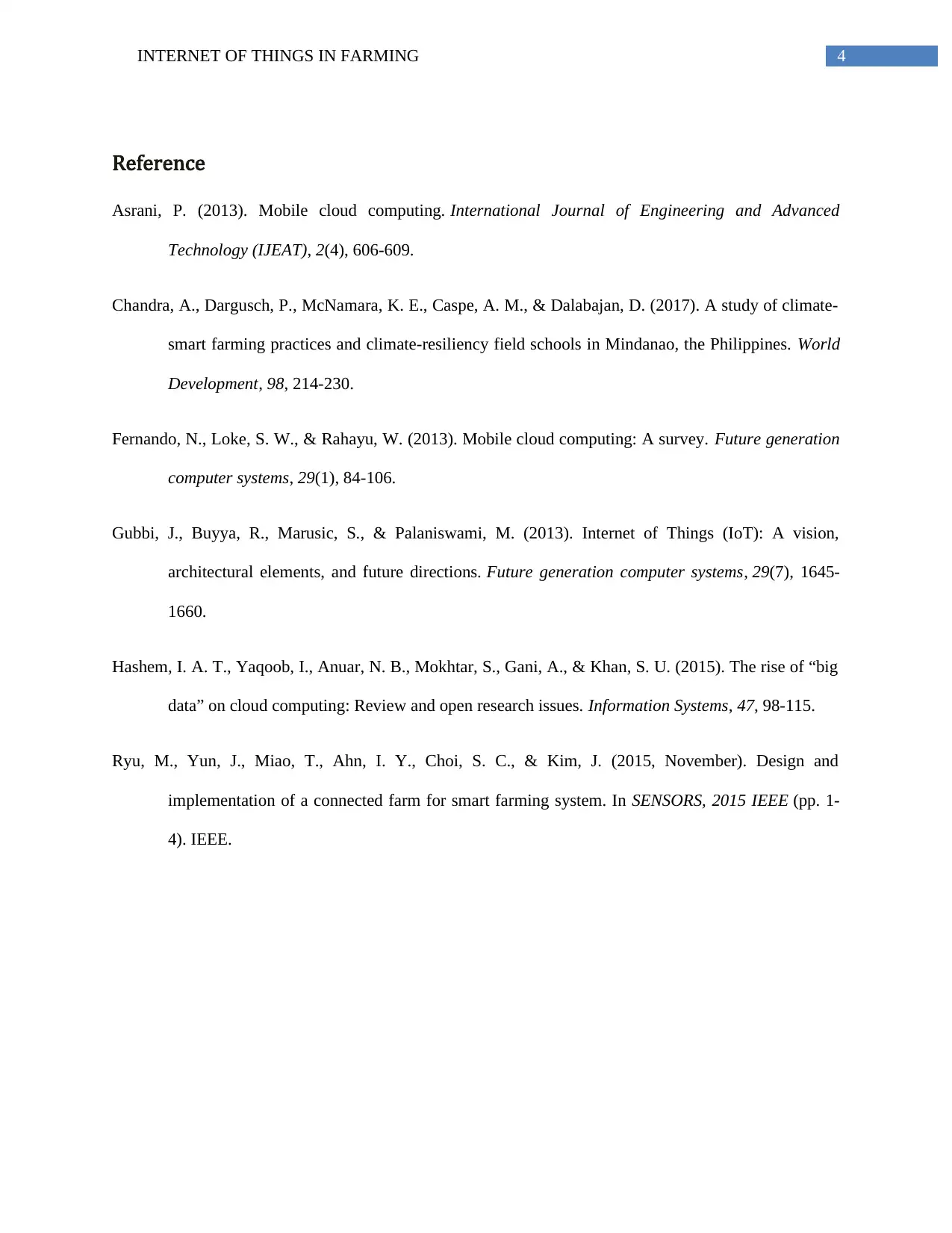
4INTERNET OF THINGS IN FARMING
Reference
Asrani, P. (2013). Mobile cloud computing. International Journal of Engineering and Advanced
Technology (IJEAT), 2(4), 606-609.
Chandra, A., Dargusch, P., McNamara, K. E., Caspe, A. M., & Dalabajan, D. (2017). A study of climate-
smart farming practices and climate-resiliency field schools in Mindanao, the Philippines. World
Development, 98, 214-230.
Fernando, N., Loke, S. W., & Rahayu, W. (2013). Mobile cloud computing: A survey. Future generation
computer systems, 29(1), 84-106.
Gubbi, J., Buyya, R., Marusic, S., & Palaniswami, M. (2013). Internet of Things (IoT): A vision,
architectural elements, and future directions. Future generation computer systems, 29(7), 1645-
1660.
Hashem, I. A. T., Yaqoob, I., Anuar, N. B., Mokhtar, S., Gani, A., & Khan, S. U. (2015). The rise of “big
data” on cloud computing: Review and open research issues. Information Systems, 47, 98-115.
Ryu, M., Yun, J., Miao, T., Ahn, I. Y., Choi, S. C., & Kim, J. (2015, November). Design and
implementation of a connected farm for smart farming system. In SENSORS, 2015 IEEE (pp. 1-
4). IEEE.
Reference
Asrani, P. (2013). Mobile cloud computing. International Journal of Engineering and Advanced
Technology (IJEAT), 2(4), 606-609.
Chandra, A., Dargusch, P., McNamara, K. E., Caspe, A. M., & Dalabajan, D. (2017). A study of climate-
smart farming practices and climate-resiliency field schools in Mindanao, the Philippines. World
Development, 98, 214-230.
Fernando, N., Loke, S. W., & Rahayu, W. (2013). Mobile cloud computing: A survey. Future generation
computer systems, 29(1), 84-106.
Gubbi, J., Buyya, R., Marusic, S., & Palaniswami, M. (2013). Internet of Things (IoT): A vision,
architectural elements, and future directions. Future generation computer systems, 29(7), 1645-
1660.
Hashem, I. A. T., Yaqoob, I., Anuar, N. B., Mokhtar, S., Gani, A., & Khan, S. U. (2015). The rise of “big
data” on cloud computing: Review and open research issues. Information Systems, 47, 98-115.
Ryu, M., Yun, J., Miao, T., Ahn, I. Y., Choi, S. C., & Kim, J. (2015, November). Design and
implementation of a connected farm for smart farming system. In SENSORS, 2015 IEEE (pp. 1-
4). IEEE.
1 out of 5
Related Documents
Your All-in-One AI-Powered Toolkit for Academic Success.
+13062052269
info@desklib.com
Available 24*7 on WhatsApp / Email
![[object Object]](/_next/static/media/star-bottom.7253800d.svg)
Unlock your academic potential
Copyright © 2020–2025 A2Z Services. All Rights Reserved. Developed and managed by ZUCOL.





